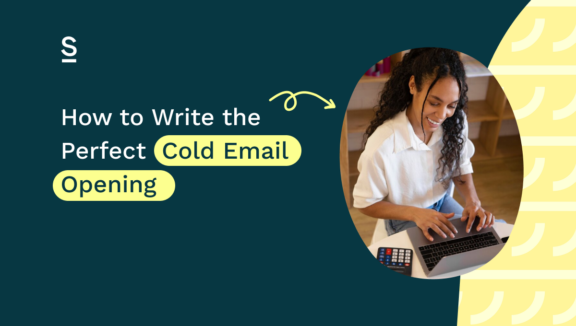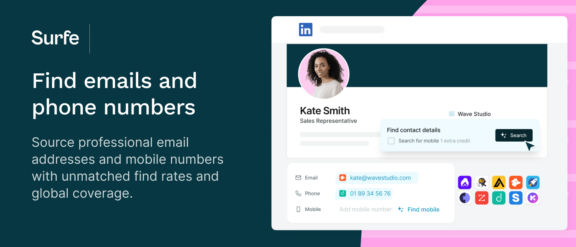How to Write the Perfect Cold Email Opening

Think about the last time you met someone new.
Did they come across as so fun and interesting that you continued the conversation?
Maybe their vibe was so snooze-worthy that you cut your chat short?
Or were they so abrupt and unfriendly that you left feeling a bit awkward?
Whichever one it was, imagine that’s how your next prospect will feel when they read your cold email. The first thing to think about after you use a free email lookup tool is that first impressions are everything – and in a world of very short attention spans and very full inboxes, you’ve got to make sure your cold email opening gives the right one.
At most, you’ve got a couple of seconds to capture your reader’s attention and, ultimately, move the conversation along. In other words: your introduction is make-or-break when it comes to your success rates.
If you’ve realized how important introductions are by now (and if you haven’t, we suggest you start from the top again), keep reading. This blog post is going to show you how to get them tip-top, every time:
- How to get your cold email greeting right
- How to nail your cold email opening line
- Common cold email mistakes to avoid
Once you’ve put our tips into action, you’ll start to see your engagement and response rates go through the roof – and you’ll be well on your way to closing more deals than ever before.
Can’t wait to get started? Neither can we. Let’s go:
How To Get Your Cold Email Greeting Right
The word you use to greet your recipient sets the tone for the entire email. You used a free em
Think about the three people you met at the start of this blog post: the friendly one would probably go for something like ‘Hey’, the dull one might open with ‘Dear Sir/Madam’, and the abrupt one might not even bother with a greeting at all.
So, where to start? Research from SalesLoft shows that using ‘Hey’ can boost reply rates by a whopping 23%, while, interestingly, ‘Hi’ boosts them by just 1% in comparison. Want to give your emails the kiss of death? ‘Hello’ reduces reply rates by 9%.
That said, responses to different greetings are going to depend on the industry you’re in and the type of professional you’re emailing. A good rule of thumb for your greeting is to think about how you’d like yourself – and your business – to be perceived.
As always, the best way to find out what works for you is to test and learn. A/B test your greetings, and you’ll come to the best word for you sooner rather than later.
Personalizing Your Cold Email Greetings
Ok, we’ve got the first word out of the way. Onto the next.
We’d recommend using the recipient’s name in your greeting (if we have to spell it out, that’s ‘Hey [name] or ‘Hi [name]’).
This is personalization 101. Back in the day, greeting by name was considered a gold standard but nowadays it’s pretty basic. Your prospects expect it – and if they open an email that doesn’t address them by their name, it’s going to feel like a marketing email rather than something you’ve lovingly poured your blood, sweat, and tears into.
Got it? Good.
Best Cold Email Greetings
Now time to put it all together and run through the different cold email greetings:
Formal greetings: best used if your clients are more corporate or in old-school industries. For example, ‘Dear [Name] or ‘Good morning [Name]’.
Informal greetings: these work in most places. If you’re selling to a younger company or the business’s brand seems more relaxed you’re good to go. For example, ‘Hey [Name], ‘Hi [Name], or [Hello name].
How to Nail Your Cold Email Opening Lines
Opening lines are what come after your greeting. If the greeting sets the tone, the opening line is what grabs – and holds – the recipient’s attention. Fail to do this, and the rest of your email’s going to get scanned at best or ignored at worst.
Just to dial the pressure up a bit more, you’ve got three seconds – or even less – to get it right. A cold email opening shouldn’t be longer than 2 or 3 sentences max. Don’t worry, though. We’ve got you.
Personalizing Your Cold Email Opening
Here’s a secret: humans bond over shared experiences. That friendly person from the start of this blog post? You probably wanted to carry on talking to them because you had something in common with them, or felt a connection in a way you couldn’t quite put your finger on.
Personalization gives you the chance to do the same over cold email. All you have to do is tailor your greeting based on a shared interest, a recent achievement, or a piece of content the recipient posted online.
For example, notice that they’ve published a LinkedIn post about your shared industry? Tell them: ‘Your recent post on [Topic]caught my attention’ or ‘I noticed your passion for [Industry Cause]’.
Best Cold Email Opening Techniques
Next up, we’re going to run through several ways you can approach your cold email openings. Next time you’ve got a bit of email writer’s block, try one of these out:
Creative and engaging openers: here you want to craft something that stands out and piques their curiosity. For example ‘I’ve got something for you’ or ‘Let’s talk about [Shared Interest]’.
Tip: you don’t want to make hooks like this disingenuous. Don’t use an opening hook that has literally nothing to do with the content underneath it – all you’re going to do is irritate your prospects.
Asking a question: here’s a way to give them a CTA that feels pretty low-stakes to act on. Questions can be a great way to connect with your prospect by making them feel understood – and immediately shows them what you’re emailing about. For example: ‘Have you ever experienced [Industry Pain Point]?’
Using what they care about: sad truth, but the world doesn’t revolve around you. Your prospect’s world revolves around them – and you can use this to your advantage by talking about something you know they’ll care about. This could be how they look to their boss, how well their company does or a pain point their role struggles with, for example.

Common Cold Email Mistakes to Avoid
Now you’ve got the greeting and opening lines down, it’s important to keep an eye out for these common pitfalls:
Overly generic openings: sales reps often fall into this trap when they’re sending out mass emails. Let’s say you choose a pain point that everyone struggles with – not having enough time, for example – your prospect’s probably not going deeply connect with your email.
Getting the context wrong: if you’re sending an email to the CEO of a big insurance corporate, you probably don’t want to start your message with ‘What’s up [Name]?!’. On the other end of the spectrum, something too formal might seem out of touch to a manager at a startup. Even worse is when you send the email to the wrong contact! Which is why we recommend using an email finder and validator.
Using outdated templates: when you’ve got a template that works, it can be tempting to squeeze every last ounce of value out of it – and you should! That said, make sure you’re not talking about an industry event that’s six months out of date, or referring to the tough funding market when things have started to pick up.
Personalization vs Automation: there’s no point in spending hours personalizing each email when you’ve got a list of three hundred people to email. On the other hand, over-automating is going to lead to generic emails mentioned above. There are loads of tools to help you get the balance right here – the best ones swap content blocks in and out depending on who you’re emailing, so you can be sure that your prospects get value out of your messages, every time.
Let’s Wrap It Up!
So there you have it: strategies to make sure your prospects are engaged and interested in what you have to say from the moment they start reading your email.
Think about your context, keep things personal, and add just the right amount of sparkle, and your reply rates will start shooting up before you know it. Next thing you know, you’ll be adding ‘Cold Email Opening Expert’ to your LinkedIn header.

So, you’re ready to put your new email openings to work?
Better find some email addresses to send them to! That’s where Surfe comes in – you can even give us a try for free.
FAQs About Writing the Perfect Cold Email Opening
What Greeting Should I Use in a Cold Email Template?
The greeting you use in a cold email template will depend on the industry you’re in, the profile of the person you’re emailing, and how you’d like the tone of the relationship to develop. For example, if you’re emailing the CEO of a big corporate a more formal ‘Dear [Name]’ or [Good morning [Name]’ will be appropriate. A more casual industry or junior profile will require something a little less formal.
How to Start a Cold Email Template?
Start a cold email template with one of the following personalized greetings:
- Hey [Name]
- Hello [Name]
- Hi [Name]
- Dear [Name]
- Good morning [Name]
- [Name]
How to Introduce Yourself in a Cold Email?
The main thing to keep in mind when introducing yourself in a cold email is to keep it brief – you have 2 or 3 sentences to grab your prospects’ attention at best, and you don’t want to use these up talking about yourself. ‘[Name] from [Company] here’ is an effective quick introduction. Alternatively, you could edit your sender name and do away with introducing yourself in the email body entirely.
How do you Write a Killer Cold Email?
The best way to write a cold email is to keep it as personalized as possible. Do this by: addressing the prospect by their first name, referring to a common industry-specific pain point, referencing something they’ve posted on social media, or naming a mutual contact. Maintain a personal feel throughout, and you’re far more likely to get a response to your cold email.
What’s the Best Introduction for a Cold Email?
The best introduction for a cold email is one that is short, to the point, and piques the recipient’s interest. You can best do this through personalization, and writing something creative that entices them to keep reading – asking a question, hinting about the rest of the email content, or using a hook.


